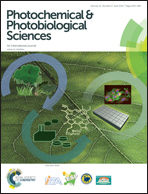The singlet-oxygen-sensitized delayed fluorescence in mammalian cells: a time-resolved microscopy approach
Abstract
The present work provides a proof-of-concept that the singlet oxygen-sensitized delayed fluorescence (SOSDF) can be detected from individual living mammalian cells in a time-resolved microscopy experiment. To this end, 3T3 mouse fibroblasts incubated with 100 μM TPPS4 or TMPyP were used and the microsecond kinetics of the delayed fluorescence (DF) were recorded. The analysis revealed that SOSDF is the major component of the overall DF signal. The microscopy approach enables precise control of experimental conditions – the DF kinetics are clearly influenced by the presence of the 1O2 quencher (sodium azide), H2O/D2O exchange, and the oxygen concentration. Analysis of SOSDF kinetics, which was reconstructed as a difference DF kinetics between the unquenched and the NaN3-quenched samples, provides a cellular 1O2 lifetime of τΔ = 1–2 μs and a TPPS4 triplet lifetime of τT = 22 ± 5 μs in agreement with previously published values. The short SOSDF acquisition times, typically in the range of tens of seconds, enable us to study the dynamic cellular processes. It is shown that SOSDF lifetimes increase during PDT-like treatment, which may provide valuable information about changes of the intracellular microenvironment. SOSDF is proposed and evaluated as an alternative tool for 1O2 detection in biological systems.


 Please wait while we load your content...
Please wait while we load your content...